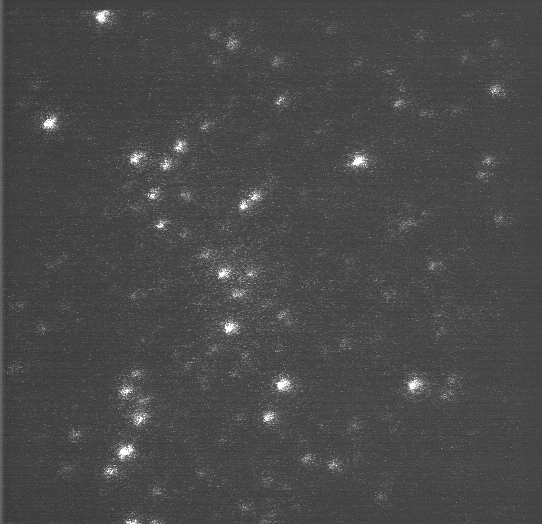LuckyCam on the Nordic Optical Telescope (NOT)
We have used a front-illuminated L3CCD on the NOT 2.5m telescope on La Palma on three runs so far. The run in 2002 suffered from bad weather (dust and wind). However the run in 2003 was extremely successful. In June/July 2003 we took 1.95 million images, 320 Gbytes of data in 8 nights. The seeing was generally good, ranging from 0.5 arcsec to about 1.5 arcsec. We took a lot of calibration data, and on this page are shown some of our results obtained so far.
We used a CCD 87 front illuminated L3CCD detector from E2V Technologies Ltd. This chip has 512 by 512 pixels of 16 microns square. The CCD chip was mounted in the liquid nitrogen cooled vacuum dewar operating at approximately -120 centigrade. We originally used a CCD controller which was based on a much older design with a maximum pixel rate of only 4MHz, but with 14 bit digitisation. The data were taken into a host computer running under Windows and after a run of approximately 400MB the data were stored on a fast RAID array disc drive. At the end of the night these data were backed up from the RAID array to high-volume IDE discs on the same machine which were removed for archive purposes. In early 2005, the entire camera system was replaced by a next-generation unit that runs with a faster pixel rate and is able to store data continually throughout the night. It leads to a considerable improvement in overall observing efficiency. At present this camera runs at a pixel rate of about 7 MHz. The data that are reported in the paper on very low mass binaries were all taken with the new camera system in June 2005.
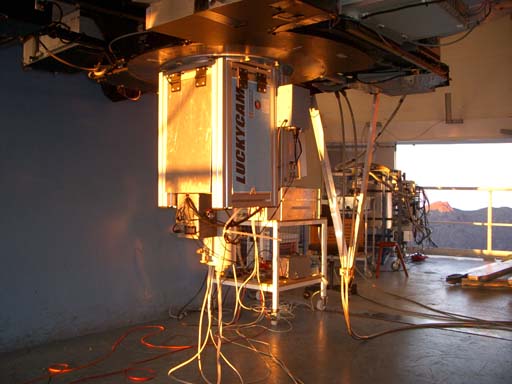
| Figure 1: The LuckyCam on the NOT telescope on la Palma in June 2003. |
The brightest stars in this field are about 13.4 Mag, and the faintest visible in each frame are about 15.1 mag. The frame time is 30 msec, and the frame size is 20 x 6.5 arc sec. Again even at this slower frame rate it is clear that when the images are sharp in one part of the frame they are also sharp over much of the frame.
The third movie shown here is also of the core of the globular cluster M15.
To see the movie (15.5 MBytes animated GIF format) click on the above image.The brightest stars are about I=13.5 mag, and the faintest visible in each frame are about I=15.8 mag. The frame time is 80 msec, and the frame size is 20 x 20 arc sec. What is remarkable in this sequence of images is that even at this frame rate which would normally be considered far too slow for any real attempt to freeze atmospheric seeing effects, we still see a remarkable correlation in the good frames where images are most compact over much of the frame.
Using the Lucky imaging methods on a run of 1000 images and selecting 10% of the total we have the image shown here.
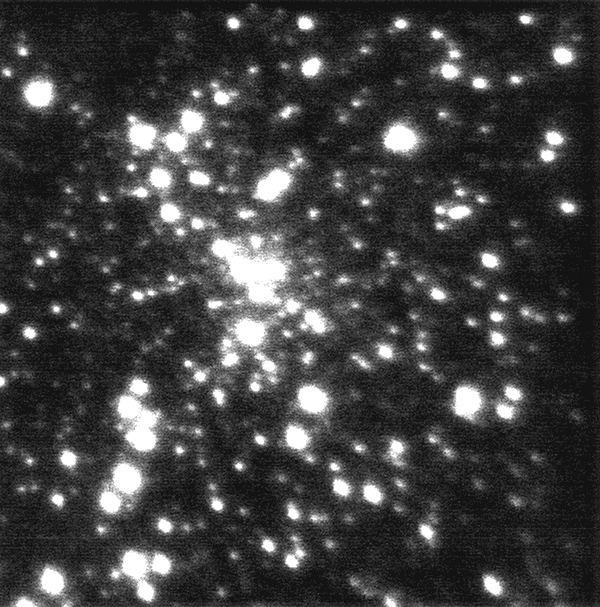
There are about 200 stars in this field, and the faintest star easily visible in the field is about I=17.7 mag (and this limit is set by crowding: in other less crowded parts of the globular cluster, the limit is I = 18.3 mag.). This image is therefore obtained with 10% of an 80 second exposure or a total exposure time of only eight seconds. The images in this field have a full width at half maximum of approximately 0.13 arc seconds.
Reference Object limits:
In order to allow us to assess image quality properly we need to have an adequate signal-to-noise on the reference object in every selected frame . We can use the data from the globular cluster fields to let us study how faint a reference object we can use reliably.
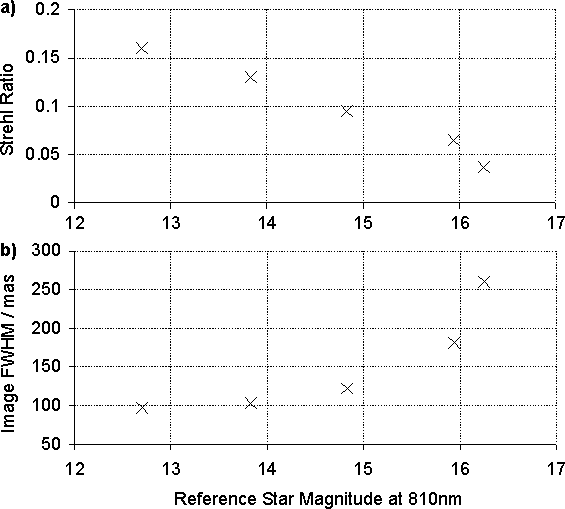
| Figure: (from July 2002 data) shows how the Strehl ratio and the image full width at half maximum depends on the magnitude of the reference stars. |
From these results we find that we can work to ~16.0 Mag (I) with non-thinned CCDs, and not in photon-counting mode. We expect to be able to work with significantly fainter reference stars with thinned photon-counting CCD. In addition when we are able to use the slowest frame rates such as is shown above in the 512 by 512 taken at 12 frames per second we should be able to reach even fainter limits for our reference star.
At these magnitudes, the probability of finding a star of a particular magnitude within our isoplanatic patch (50 arcsec diameter) is much greater. That our present limits it is 20% already, and we should reach a very much higher percentage with a thinned CCD , particularly at the lower frame rates. It is also worth remembering that there is nothing to stop us using a mean Strehl ratio of several fainter stars
Effect of Selection percentage:
With Lucky Imaging the highest resolution is achieved by selecting the smallest fraction and therefore only using the very best images. However this gives us a very poor efficiency, and relatively poor limiting magnitude. In practice, however, we can select a larger fraction of images. This will give us somewhat poorer resolution, but still we obtained dramatically better images than we would get from a conventional long-exposure image. Even simply selecting the best 50% of the images means we have chosen the better half, and discarded the worst half. We are able to do this trade-off after the end of the exposure. This allows us to make images by using an increasing fraction of the exposures and deciding whether the improvement in sensitivity is preferable to the slight loss in resolution. The decision about which fraction to use may be made after the exposure, and may be different for different observing programmes, even on the same field.
To give some idea of how this actually works we show here a set of four images each corresponding to a different fraction selected from the same observing run and beside them them a one-dimensional cut through a typical star image.
Plots are for star 10 arcsec from reference star, 12 Hz frame rate and:
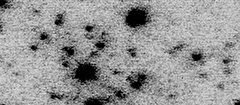

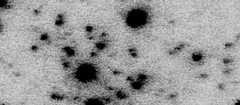

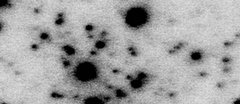

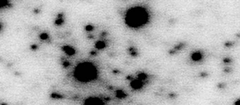

Limiting Magnitudes:
We find from our results that we already achieve 18.7 mag (I-band) in 80 seconds and 10% selection (i.e. we use 8 secs of recorded data) with an unthinned (front illuminated) L3CCD. The limiting magnitude is potentially very deep. With 1 hour total exposure and 3% selection, the limit with a thinned CCD would be I~22.3 mag. and would achieve a resolution of typically 140 marcsec, assuming “seeing” of ~0.5 arcsec. With 10% selection I~23.6 would be reached in about 1 hour, though with poorer resolution (~160 marcsec).
Hubble Space Telescope Resolution from the Ground
We shall here a composite image. An HST wide field/planetary camera image near the core of M13 makes up the background with Lucky Imaging of one area and Adaptive Optics images of another nearby superposed, along with a comparison of the image profiles of the HST and Lucky Imaging data.
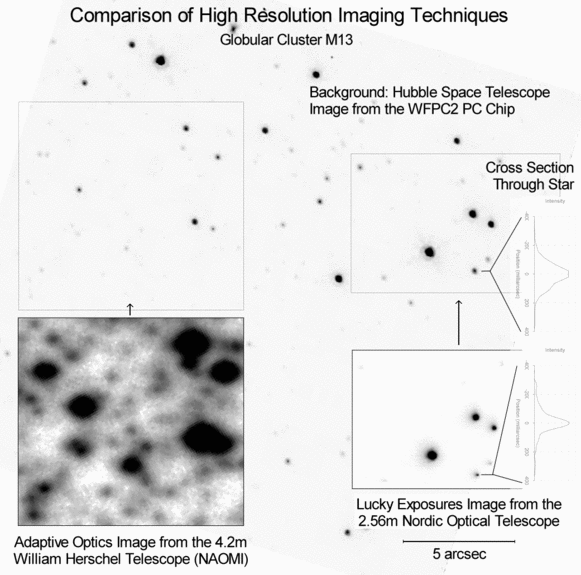
| HST background image: WFPC2 870nm, Stellar FWHM 0.12 - 0.15 arcseconds. Lucky image: NOT 810nm, Stellar FWHM 0.10 arcseconds WHT Adaptive Optics NAOMI 660nm, Stellar FWHM 0.4 arcseconds |

